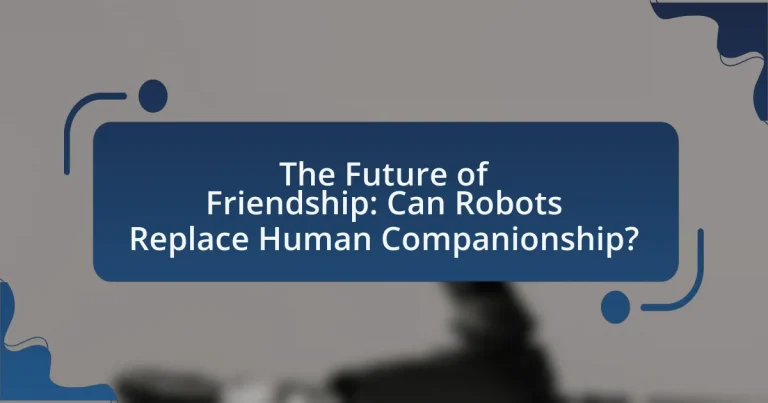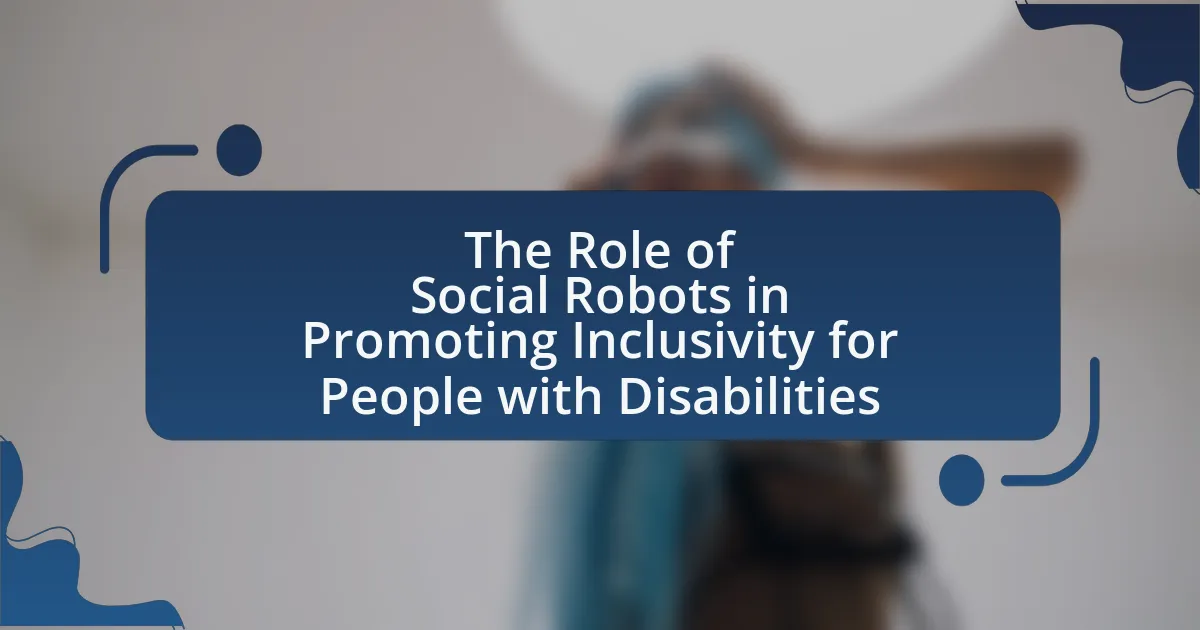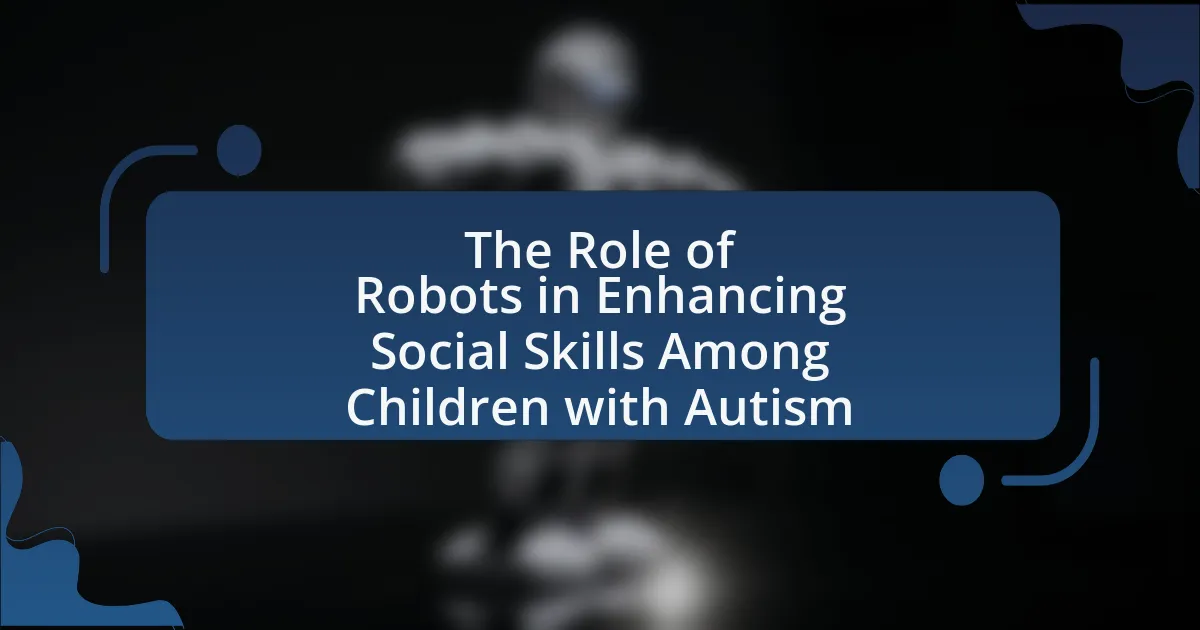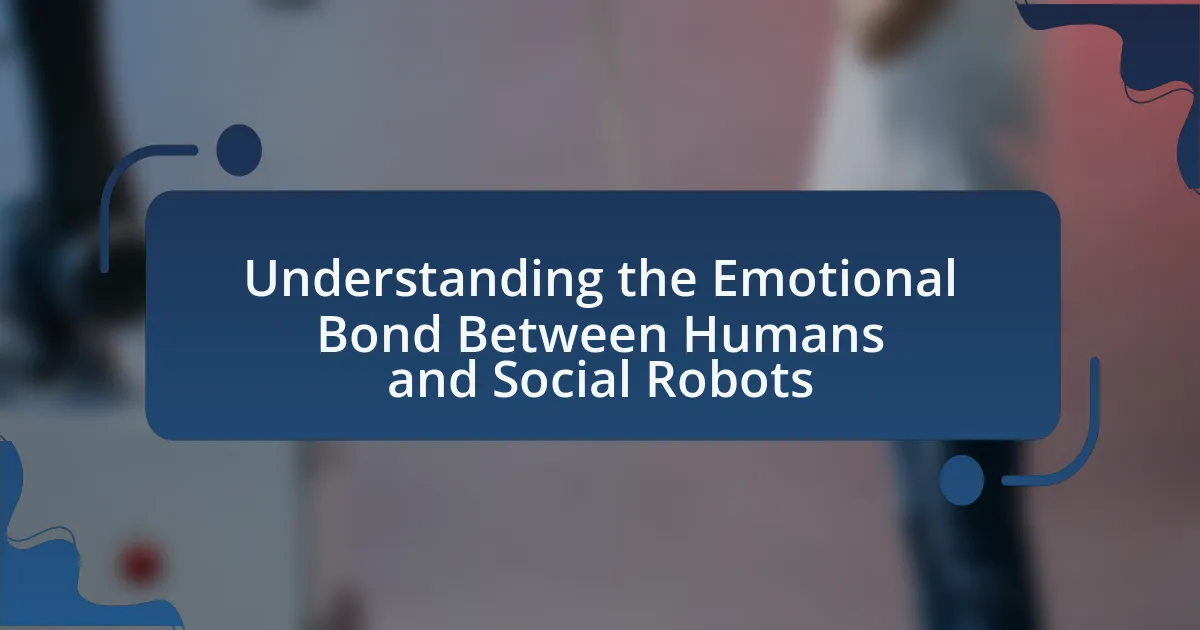The article examines the evolving role of robots in providing companionship and emotional support, particularly in the context of social interactions and addressing loneliness. It highlights advancements in artificial intelligence that enable robots to engage in empathetic interactions, particularly in healthcare and educational settings. The discussion includes various types of companion robots, their limitations in emotional understanding compared to humans, and the potential benefits and challenges of robotic companionship. Additionally, the article explores societal perceptions of robots, ethical considerations in their development, and the implications for human relationships as robotic companions become more integrated into daily life.

What is the Future of Friendship in the Context of Robotics?
The future of friendship in the context of robotics suggests that robots will increasingly serve as companions, potentially fulfilling emotional and social needs traditionally met by human relationships. Advances in artificial intelligence and robotics, such as the development of empathetic robots capable of understanding and responding to human emotions, indicate a growing role for robots in social interactions. For instance, studies have shown that individuals can form attachments to robotic companions, as evidenced by research from the University of California, which found that elderly participants reported feelings of companionship and reduced loneliness when interacting with social robots. This trend indicates that while robots may not fully replace human companionship, they will likely become significant adjuncts in addressing social isolation and enhancing emotional well-being.
How are robots currently being integrated into social interactions?
Robots are currently being integrated into social interactions through applications in healthcare, education, and companionship. In healthcare, robots like social assistive robots are used to provide emotional support and companionship to elderly patients, improving their mental well-being and reducing feelings of loneliness. For example, studies have shown that interactions with robots like PARO, a therapeutic robotic seal, can significantly enhance the mood of dementia patients. In educational settings, robots serve as interactive learning tools, engaging students in collaborative activities and fostering social skills. Furthermore, companion robots, such as those developed by companies like SoftBank Robotics, are designed to interact with users in a friendly manner, providing companionship and conversation, which can help alleviate social isolation. These integrations demonstrate the growing role of robots in enhancing social interactions across various domains.
What types of robots are designed for companionship?
Companion robots are specifically designed to provide social interaction and emotional support to humans. These robots can be categorized into several types, including social robots, therapeutic robots, and pet robots. Social robots, such as Pepper and Jibo, engage in conversation and can recognize human emotions, enhancing social interaction. Therapeutic robots, like Paro, a robotic seal, are used in healthcare settings to provide comfort and companionship to patients, particularly the elderly or those with cognitive impairments. Pet robots, such as Aibo, mimic the behavior of real pets, offering companionship without the responsibilities of live animals. These types of robots are increasingly utilized to address loneliness and improve mental well-being, demonstrating their role in companionship.
How do these robots simulate human-like interactions?
Robots simulate human-like interactions through advanced algorithms, natural language processing, and emotional recognition technologies. These systems enable robots to understand and respond to human speech, recognize emotional cues, and engage in contextually relevant conversations. For instance, social robots like Sophia utilize machine learning to improve their conversational abilities over time, allowing them to mimic human social behaviors effectively. Research indicates that robots equipped with these technologies can enhance user engagement and emotional connection, as demonstrated in studies showing increased user satisfaction when interacting with emotionally responsive robots.
What are the potential benefits of robotic companionship?
Robotic companionship offers several potential benefits, including enhanced emotional support, reduced feelings of loneliness, and improved mental health. Studies have shown that interactions with robots can stimulate social engagement, particularly among the elderly, leading to increased feelings of companionship and decreased isolation. For instance, research published in the journal “Gerontology” found that seniors who interacted with robotic pets reported lower levels of depression and anxiety. Additionally, robotic companions can assist with daily tasks, providing practical support that enhances the quality of life for individuals with mobility challenges or cognitive impairments.
How can robots help alleviate loneliness in individuals?
Robots can help alleviate loneliness in individuals by providing companionship and social interaction. Socially assistive robots, such as Paro the therapeutic seal and ElliQ, have been shown to engage users in conversation, stimulate cognitive function, and offer emotional support. Research indicates that interactions with these robots can lead to reduced feelings of isolation and improved mental well-being, particularly among the elderly. For instance, a study published in the journal “Gerontology” found that elderly participants who interacted with robotic companions reported lower levels of loneliness and increased social engagement.
What emotional support can robots provide compared to humans?
Robots can provide emotional support through companionship, consistency, and non-judgmental interaction, but they lack the depth of empathy and understanding that humans offer. For instance, social robots like Paro, a therapeutic robot seal, have been shown to reduce feelings of loneliness and anxiety in elderly patients, demonstrating their ability to provide comfort. However, studies indicate that while robots can simulate emotional responses, they do not possess genuine emotional intelligence, which is crucial for nuanced human interactions. Research published in the journal “Science Robotics” highlights that robots can effectively engage users in structured emotional support scenarios, yet they cannot fully replicate the complex emotional connections formed through human relationships.
What challenges do robots face in replacing human companionship?
Robots face significant challenges in replacing human companionship, primarily due to their inability to replicate emotional depth and social nuances inherent in human relationships. Unlike humans, robots lack genuine empathy, which is crucial for forming meaningful connections; studies show that emotional intelligence is a key factor in companionship, and robots currently do not possess this capability. Furthermore, the complexity of human communication, including non-verbal cues and contextual understanding, poses a barrier for robots, as they often struggle to interpret and respond appropriately to these subtleties. Research indicates that while robots can simulate conversation, they cannot fully engage in the emotional reciprocity that characterizes human interactions, limiting their effectiveness as companions.
What limitations do current robots have in understanding human emotions?
Current robots have significant limitations in understanding human emotions due to their reliance on programmed algorithms and lack of genuine emotional experience. These robots primarily analyze facial expressions, voice tone, and body language to interpret emotions, but they often misinterpret nuanced human feelings because they lack contextual understanding and empathy. For instance, a study published in the journal “Science Robotics” highlights that robots struggle with recognizing complex emotions like sarcasm or mixed feelings, which require a deep understanding of social context and human experiences. Additionally, robots do not possess consciousness or emotional intelligence, which further restricts their ability to engage in meaningful emotional interactions.
How do societal perceptions of robots affect their acceptance as companions?
Societal perceptions of robots significantly influence their acceptance as companions. Positive perceptions, such as viewing robots as helpful and friendly, enhance acceptance, while negative views, like fear of job displacement or emotional detachment, hinder it. Research indicates that familiarity with robots increases comfort levels; for instance, a study by the University of Southern California found that individuals who interacted with robots regularly were more likely to accept them as companions. Additionally, cultural factors play a role; societies that embrace technology tend to have higher acceptance rates for robotic companions.
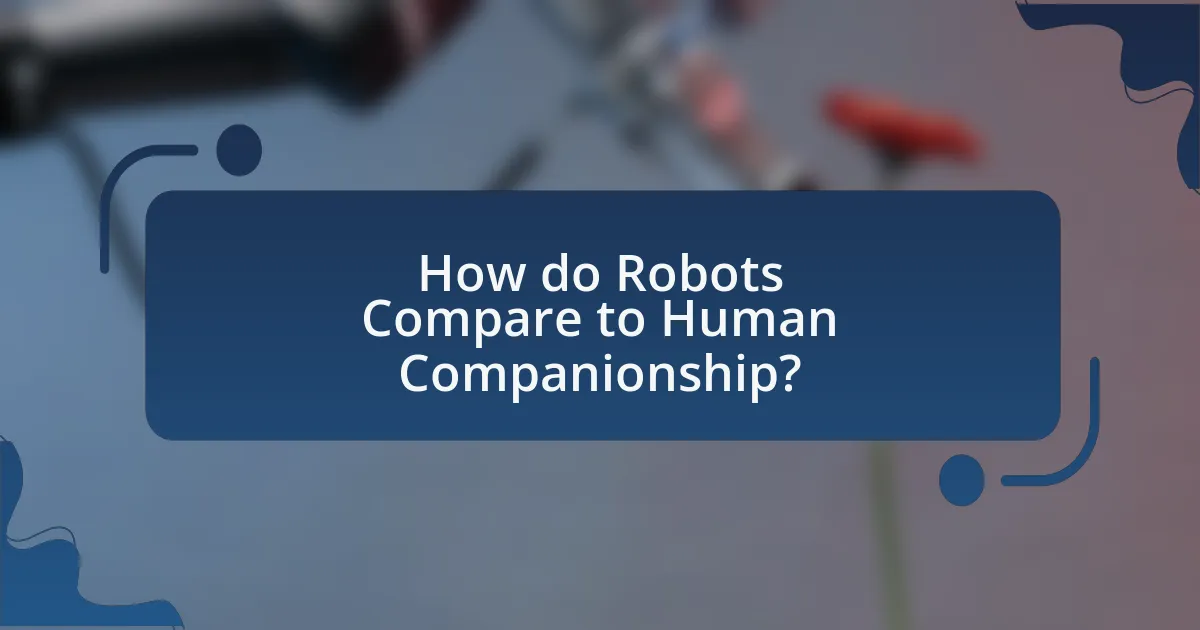
How do Robots Compare to Human Companionship?
Robots provide companionship that differs significantly from human companionship in emotional depth and social understanding. While robots can simulate conversation and respond to emotional cues, they lack genuine empathy and the ability to form complex emotional bonds that humans naturally develop. Research indicates that human companionship is essential for emotional well-being, as studies show that social interactions with humans lead to increased happiness and reduced stress levels, whereas interactions with robots do not replicate these effects. For instance, a study published in the journal “Computers in Human Behavior” found that while robots can alleviate feelings of loneliness, they do not fulfill the emotional needs that human relationships satisfy.
What are the key differences between robots and human friends?
Robots and human friends differ fundamentally in emotional intelligence and social interaction. Human friends possess the ability to understand and respond to complex emotions, fostering deep connections through empathy and shared experiences. In contrast, robots operate based on programmed algorithms and lack genuine emotional understanding, limiting their ability to form authentic relationships. Research indicates that human interactions are enriched by non-verbal cues and emotional nuances, which robots cannot replicate. For instance, studies show that human friendships contribute to mental well-being, while robots, despite their utility, cannot provide the same emotional support or companionship.
How does emotional intelligence differ between robots and humans?
Emotional intelligence in humans involves the ability to perceive, understand, and manage emotions in oneself and others, which is rooted in complex biological and psychological processes. In contrast, robots exhibit a form of emotional intelligence that is primarily algorithmic and based on programmed responses to emotional cues, lacking genuine emotional experience. For example, while humans can empathize and form deep emotional connections through shared experiences, robots can only simulate empathy through pre-defined algorithms and data analysis, such as recognizing facial expressions or vocal tones. This fundamental difference highlights that human emotional intelligence is inherently tied to consciousness and subjective experience, whereas robotic emotional intelligence is limited to computational interpretations and responses.
What social skills are lacking in robotic companions?
Robotic companions lack essential social skills such as empathy, emotional intelligence, and nuanced communication. These deficiencies hinder their ability to understand and respond appropriately to human emotions and social cues, which are critical for meaningful interactions. For instance, while robots can be programmed to recognize basic emotions through facial expressions, they struggle to interpret complex emotional states or respond with genuine empathy, as evidenced by studies showing that human emotional responses are often context-dependent and require a level of understanding that current AI lacks.
Can robots fulfill the same roles as human friends?
Robots cannot fully fulfill the same roles as human friends. While robots can provide companionship and perform specific tasks that mimic friendship, such as engaging in conversation or offering emotional support, they lack the depth of emotional understanding, empathy, and shared experiences that characterize human relationships. Research indicates that human friendships are built on complex emotional connections and social interactions that robots, even with advanced AI, cannot replicate. For instance, a study published in the journal “Social Robotics” highlights that while robots can simulate social behaviors, they do not possess genuine emotional intelligence or the ability to form authentic bonds, which are essential components of true friendship.
What specific needs do human friends meet that robots cannot?
Human friends meet emotional needs such as empathy, understanding, and genuine connection that robots cannot replicate. While robots can simulate conversation and provide companionship, they lack the ability to truly empathize or understand complex human emotions. Research indicates that human interactions foster emotional support and social bonding, which are crucial for mental health and well-being. For instance, studies show that friendships can reduce stress and increase happiness, highlighting the irreplaceable role of human connection in fulfilling emotional needs.
How do robots handle complex social situations compared to humans?
Robots handle complex social situations through programmed algorithms and machine learning, which allow them to analyze and respond to social cues, but they lack the emotional depth and contextual understanding that humans possess. While robots can simulate social interactions by recognizing patterns and responding appropriately, they do not experience emotions or empathy, which are crucial for navigating nuanced human relationships. Research indicates that robots can perform tasks like recognizing facial expressions and responding to verbal cues, yet they struggle with the subtleties of human emotions and the complexities of social dynamics, as evidenced by studies showing that human interactions often rely on unspoken social norms and emotional intelligence that robots cannot replicate.
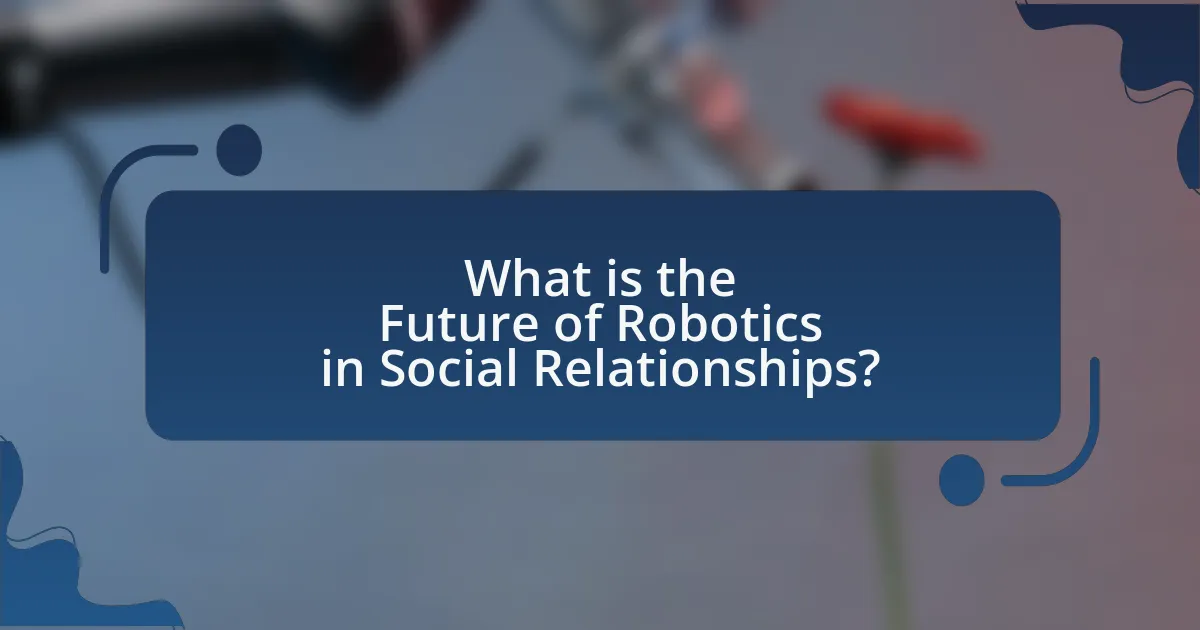
What is the Future of Robotics in Social Relationships?
The future of robotics in social relationships is poised to enhance human interaction through companionship and support. As advancements in artificial intelligence and robotics continue, robots are increasingly designed to engage in meaningful social interactions, providing emotional support and companionship, particularly for the elderly and individuals with social anxiety. Research indicates that robots like social companion robots can improve mental well-being; for instance, a study published in the journal “Gerontechnology” found that elderly individuals reported increased feelings of happiness and reduced loneliness when interacting with robotic companions. This trend suggests that while robots may not fully replace human companionship, they will play a significant role in complementing social relationships and addressing emotional needs.
How might advancements in AI change the landscape of companionship?
Advancements in AI are likely to transform companionship by enabling the development of highly personalized and emotionally intelligent virtual companions. These AI systems can analyze user preferences, emotional states, and social behaviors to provide tailored interactions that mimic human companionship. For instance, research by the Stanford University Human-Centered AI Institute indicates that AI companions can enhance emotional well-being by offering support and reducing feelings of loneliness, particularly among vulnerable populations such as the elderly. As AI technology continues to evolve, the ability of these systems to engage in meaningful conversations and understand complex human emotions will further bridge the gap between human and robotic companionship.
What future technologies could enhance robotic interactions?
Future technologies that could enhance robotic interactions include advanced artificial intelligence, improved natural language processing, and enhanced sensory perception. Advanced artificial intelligence enables robots to learn from interactions and adapt their responses, making them more relatable and effective companions. Improved natural language processing allows for more nuanced and context-aware conversations, facilitating deeper emotional connections. Enhanced sensory perception, such as vision and touch, enables robots to better understand and respond to human emotions and physical cues, thereby enriching the interaction experience. These technologies collectively contribute to creating more engaging and meaningful relationships between humans and robots.
How will ethical considerations shape the development of companion robots?
Ethical considerations will significantly shape the development of companion robots by guiding their design, functionality, and interaction protocols to ensure they promote well-being and respect user autonomy. For instance, developers must address issues such as privacy, consent, and emotional manipulation, ensuring that robots do not exploit vulnerable populations, such as the elderly or children. Research indicates that ethical frameworks, like those proposed by the IEEE Global Initiative on Ethics of Autonomous and Intelligent Systems, emphasize the importance of transparency and accountability in AI systems, which directly influences how companion robots are programmed to interact with users. By integrating these ethical guidelines, developers can create companion robots that foster trust and enhance the quality of human-robot relationships, ultimately shaping a future where these technologies serve as beneficial companions rather than sources of ethical dilemmas.
What are the implications of robotic companionship on human relationships?
Robotic companionship significantly alters human relationships by introducing new dynamics of interaction and emotional support. These robots can provide companionship, reduce feelings of loneliness, and offer emotional engagement, which may lead to a shift in how individuals perceive and value human connections. Research indicates that individuals, particularly the elderly, report increased satisfaction and reduced loneliness when interacting with robotic companions, as evidenced by studies such as the one conducted by Sherry Turkle at MIT, which highlights the emotional bonds formed between humans and robots. This shift may lead to a redefinition of intimacy and social interaction, where emotional fulfillment can be derived from non-human entities, potentially diminishing the perceived necessity for traditional human relationships.
How might reliance on robots affect interpersonal skills in humans?
Reliance on robots may diminish interpersonal skills in humans by reducing face-to-face interactions. As individuals increasingly depend on robots for communication and companionship, they may experience a decline in their ability to engage in social cues, empathy, and emotional intelligence. Research indicates that frequent interaction with technology can lead to social isolation, as evidenced by a study published in the journal “Computers in Human Behavior,” which found that increased screen time correlates with decreased social skills and emotional well-being. This suggests that the more humans rely on robots, the less they practice and develop essential interpersonal skills.
What potential societal changes could arise from widespread robotic companionship?
Widespread robotic companionship could lead to significant societal changes, including altered social dynamics, shifts in mental health paradigms, and changes in economic structures. As robots become common companions, human interactions may decrease, potentially leading to increased social isolation for some individuals while providing companionship for others, particularly the elderly or those with disabilities. Research indicates that robotic companions can alleviate feelings of loneliness and depression, as seen in studies involving elderly populations where robots like PARO have shown to improve emotional well-being. Economically, the rise of robotic companionship may create new industries focused on robot design, maintenance, and programming, while also displacing jobs in caregiving and social services. These changes highlight the complex interplay between technology and society, suggesting that while robotic companions can enhance quality of life for some, they may also challenge traditional human relationships and economic roles.
What practical steps can individuals take to navigate robotic companionship?
Individuals can navigate robotic companionship by establishing clear boundaries and understanding the capabilities and limitations of the robotic companion. Setting boundaries helps define the relationship dynamics, ensuring that users maintain control over their interactions. Understanding the capabilities of the robot, such as its programming and emotional responses, allows individuals to manage their expectations and interactions effectively. Research indicates that users who actively engage with their robotic companions while maintaining realistic expectations report higher satisfaction levels (Shin, 2018, “Human-Robot Interaction: A Review”). This approach fosters a balanced relationship, enhancing the overall experience of robotic companionship.
How can one balance human relationships with robotic interactions?
To balance human relationships with robotic interactions, individuals should prioritize face-to-face communication while integrating technology as a supplementary tool. Research indicates that maintaining strong social connections enhances mental health and well-being, with studies showing that social isolation can lead to increased risks of depression and anxiety. By setting boundaries on technology use, such as designating specific times for social media or robotic interaction, individuals can ensure that human relationships remain central to their lives. Additionally, engaging in activities that foster human connections, like group hobbies or community events, can further strengthen interpersonal bonds while allowing for the use of robots in supportive roles, such as companionship or assistance in daily tasks.
What guidelines should be followed when integrating robots into social life?
When integrating robots into social life, guidelines should prioritize ethical considerations, user safety, and social acceptance. Ethical considerations include ensuring that robots respect privacy and autonomy, as highlighted by the IEEE Global Initiative on Ethics of Autonomous and Intelligent Systems, which emphasizes the importance of human rights in technology. User safety must be addressed by implementing robust safety protocols to prevent accidents, as evidenced by the development of safety standards by organizations like ISO and ANSI. Social acceptance can be fostered through public education and engagement, which has been shown to improve perceptions of technology, as noted in studies by the Pew Research Center. These guidelines collectively aim to create a harmonious coexistence between humans and robots in social settings.
